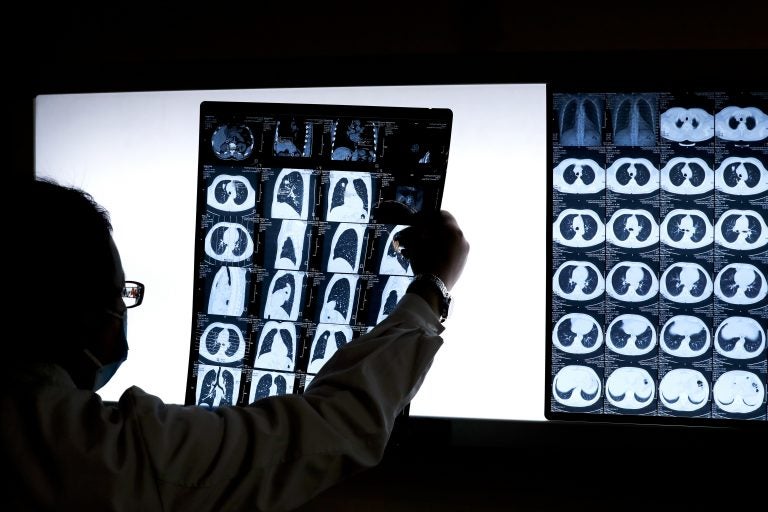Cancer deaths drop in Delaware, but new cases remain high
In the 1990s, the state had the second highest cancer mortality rate in the nation. The latest numbers show Delaware’s rate dropped to 18th highest.

A doctor looks at the CT scan of a lung cancer patient. (Andy Wong/AP Photo)
Better screening and early detection have brought Delaware’s cancer mortality rate down by 14%, according to new numbers from the state’s Cancer Consortium. The group’s report compares data from two five-year periods to get a more accurate picture.
Specifically, the report compares the number of cancer deaths between 2011 and 2015 with those between 2001 and 2005. Between 2011 and 2015, there were 175.1 cancer deaths per 100,000 people. That was down from 200.6 per 100,000 in 2001-2005.
“Many factors contribute to Delaware’s progress in reducing its cancer burden,” the report says. But screening and early detection get the credit for lowering the mortality rate, said Heather Brown, chief of the Chronic Disease Bureau for the state Division of Public Health.
“Cancer does not discriminate, so you could be a longtime smoker, you could have never smoked at all, it really is depending on your genes or how or what your lifestyle behaviors are,” Brown said. “In order to be the best you can about trying to prevent it, [it] is really looking at those risk factors and knowing that you have to live this healthy lifestyle, but nothing’s guaranteed.”
National numbers show a similar reduction, and Delaware’s cancer mortality rate is still 7% higher than the U.S. rate of 163.5 deaths per 100,000. Regionally, Pennsylvania has the 17th highest mortality rate at 171.6 deaths per 100,000. New Jersey fares much better at 36th highest, with 157.7 deaths per 100,000.
And though the number of new cancer cases diagnosed in Delaware was down 3% between 2001-2005 and 2011-2015, Delaware has the second highest number of new cases in the nation. The state’s incident rate has been high for so long, Brown said, they’re no longer falling back to blame the high rate on better screening. She said the state needs to step up its cancer-prevention efforts.
“Things like healthy eating and increased physical activity and not smoking and reduced alcohol consumption, so those are all things that contribute to incidence of cancer. Not only do we have great screening rates, yes, but we also do need to turn our attention to more prevention.”
When it comes to specific cancers, the state saw a dramatic growth in liver cancer. Even though it accounts for only 2% of newly diagnosed cancer cases in the state, or 506 cases, those represent a 75% increase compared to 2001-2005.
“In the last 10 years, we’ve had a 75% increase in liver cancer incidents, so that’s something that we were kind of surprised to see,” Brown said.
The increase is due, in part, to the hepatitis C virus. Though it is now highly curable, the virus can go undiagnosed for decades, and baby boomers are urged to get tested. Other risk factors for liver cancer include alcohol abuse, smoking and obesity.
“Liver cancer is definitely one that can be prevented, and the power to do that is in everyone’s hands,” she said.
Earlier this year, the state launched an effort to encourage longtime smokers to get a low-dose CT scan to screen for lung cancer.
“With this new way of screening, lung cancer can be detected when it’s the size of a grain of rice versus the size of a dime, so that’s a huge improvement to the detection of lung cancer and can prolong a person’s life,” Brown said.
The screening should be covered by insurance for longtime smokers. Lung cancer remains the most frequently diagnosed cancer type in Delaware, accounting for 19% of all newly diagnosed cancer cases and 29% of all cancer deaths.
WHYY is your source for fact-based, in-depth journalism and information. As a nonprofit organization, we rely on financial support from readers like you. Please give today.





